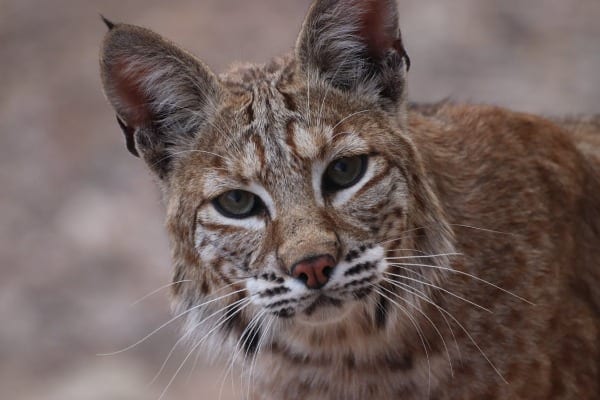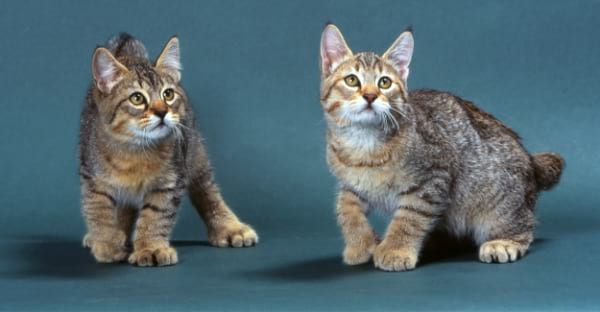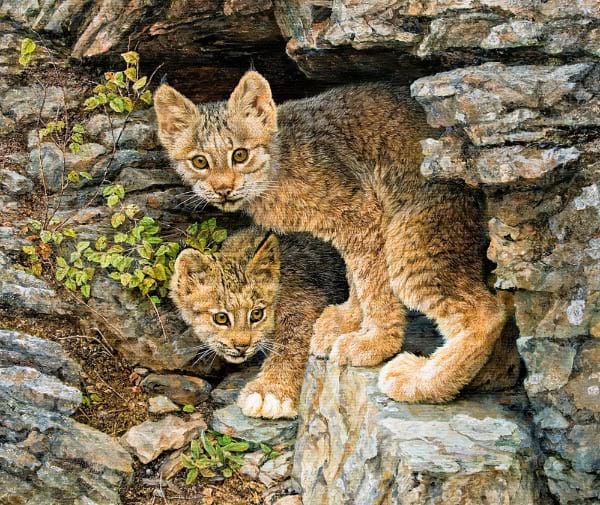A bobcat (Lynx rufus) is a wild cat with a bobbed tail and large ears, but can it be a domesticated cat? Well, there are some claims that bob cats mixed with domesticated cats do exist, but genetics cannot prove or disprove it.
Some people say that a cross between a domestic cat and a wild cat is bigger than a regular house cat, and it can be more fickle. However, a bobcat’s sweet face has made it a popular pet in its native land of North America.
In this article, we will explain how you can identify a hybrid species, describe an appearance of a Bobcat mixed with a domestic cat kitten, and outline the main differences between a regular kitten and a Bobcat kitten.
How Can You Identify A Hybrid Species?
The genetics of hybrid species are complex because they are more than just a mixture of both parental species. Thus, there is no single standard that will govern the appearance, genetics, and character of a lynx and domestic cat mix. If two different species manage to produce offspring, it can have many variations. How can you tell if a cat is a hybrid? Here we have to look at genetics.
Genetic Identification of Bobcat and Domestic Cat Hybrids

Bobcat and domestic cat hybrids don’t exist, so they cannot inhabit wild areas of the United States. However, if we hypothetically consider their existence, then we can say a few words about their features in terms of appearance. While the bay lynx is smaller than the bobcat, the two are quite similar in appearance. Like its bay lynx parent, the bobcat is also known for its stubby tail, tufted ears, and black-tipped tail. The bobcat is also known to have more gray coloring than the bay lynx. Although wolf and dog hybrids have been extensively studied and genetic testing has been developed, researchers have noted that “Commercial microsatellite arrays and DNA barcoding have not been developed for identification of bobcat/domestic cat hybrids.”
Is It Legal To Own A Bobcat/Domestic Cat Hybrid?
It depends on state/provincial laws. If you live in the United States, in some states, you can legally own a bobcat as a pet. It’s important to note that bobcats aren’t your traditional cute and cuddly kitties you see in commercials. They’re wild animals that need special care and training. You have to have the money, the time, and the patience to care for these types of creatures.
What About Rocky The Bobcat Hybrid?
One of the most famous cases of hybrid lynx is Rocky the (Maybe) Bobcat. The owner claimed that the pet was a hybrid, but the state authorities could not prove otherwise, since genetic identification is a very difficult procedure. The bobcat DNA test proved that Rocky’s mother was 100% purebred bobcat, but as for the father, it could not be proven. Thus, a legal precedent happened, which showed that the authorities cannot legally prove the cat’s genetics.
A Colorado Bobcat Hybrid Case
In Colorado, a resident was found to have a potential bobcat hybrid. The state had to prove that the animal was a hybrid. A FELV test was performed, which is associated with domestic cat diseases, so the bobcat does not have FELV. This marker was not found in the Colorado cat, which means it was a lynx. However, in the case of hybrids, things are not so clear-cut, and it is impossible to say for sure whether this result is indicative or not because the question has not been fully studied.
What About The Pixie-Bob Breed?

The Pixie-Bob cat breed has an interesting history. However, some associations, namely, the Cat Fanciers Association (CFA), don’t support the idea that this breed has a wild bobcat heritage. Let’s start from the very beginning – the appearance of these lovely furballs with a wild look.
The Pixie-Bob breed is thought to have started from the unplanned litter of a bobcat and a barn cat in 1985. The cat’s owner, Carol Ann Brewer, named a female kitty Pixie. Though there was no evidence that Pixie’s father was a wildcat, many breeders across the globe support this idea. In 1994, The International Cat Association (TICA) has officially recognized the Pixie-Bob as a breed; the American Cat Fanciers Association (ACFA) did the same in 2005. These lovely carnivores have a wooly coat of a striped or a mackerel cat pattern, they are quite large (8-12, or even 25 pounds sometimes), and are relatively healthy. Pixie bobs enjoy playing fetch, learning tricks, and spending time with their cat owners. These mellow pets have a dog-like personality, so they love hanging out with their owners and other cats. Though baby bobcats are friendly furbabies that adore humans, sometimes, like Ocicat, Bengal, or Toyger cat breeds, they can feel like wild kittens and chase birds or rabbits.
Can Bobcats and House Cats Mate?
Can bobcats breed with domestic cats? Bobcats are solitary animals by nature, but many people have reported cases of pet house cats mating with wild bobcats. Bobcats are typically between 8 and 12 pounds, and house cats are usually between 6 and 8 pounds. House cats can be just as vicious as any other wild animal. It’s possible that house cats and wild bobcats may sometimes mate, but they are not likely to occur often. Anyway, these species are too genetically different to produce litter.
How Can You Tell The Difference Between A Regular Kitten And A Bobcat Kitten?

Mix-ups between house cats and bobcats can happen because when a kitten is small, it is hard to tell a difference. We’ll try to explain how a regular kitten and a bobcat kitten differ. By using this information, you can tell if your cat is a bobcat or a typical cat.
Tail
The tail is a distinctive feature of the Manx cats as bobcat kittens have a short tail (often, a bobcat’s tail has 3-4 separate vertebrae), and the tail has a distinctive pattern – a black spot on top and a white spot on the bottom of the tail. This pattern is not characteristic of house cats.
Coat
Bobcat felines have black markings on the face and ears, and they can boast beautiful spots on their bodies. Though this pattern resembles a tabby coat pattern, it is different and can be spotted only on Bobcat kitties.
Size, Age, and Teeth
How big is a bobcat compared to a house cat? Compared to domestic kittens, lynx kittens are much larger. By 6 months of age, kittens gain approximately 1 pound per month. To determine the age of a kitten by the type of teeth, use this table.
What About The Ears?
Distinctive tufted ears grow at a more mature age, so this is not a key indicator for determining whether a kitten is a bobcat or not.
What Would A Bobcat and Housecat Hybrid Look Like?
Domestic cats and lynxes can mate, but they do not produce offspring. Consequently, we can only speculate on what a half bobcat might look like. We describe our assumptions below.
Size
There is such a thing as heterosis in science. It means that the offspring take the best from both parents, and sometimes even surpass them. This can apply to certain qualities of character and behavior, as well as to appearance. Considering that a lynx weighs about 19 pounds (for comparison, a Maine Coon weighs 18 pounds) and a cat weighs about 8 pounds, hybrid animals can even be of enormous size. Sometimes, a big cat can weigh over 19 pounds.
Tail
As we know, a pure bobcat has an adorable tail, but the tail of domestic cats is much longer. However, a hybrid’s tail can be of any length.
Legs
Various species have different characteristics in terms of appearance. Thus, the Canada lynx (Lynx canadensis) is a medium-sized lynx that lives in Alaska and Southern Canada. This animal has massive front legs and large paws. As for
Ears
Cute tufted ears are a distinctive feature of lynxes; domesticated cats do not have this feature. However, a hybrid can have any kind of ears. We can easily imagine more complex Maine Coon ears. They will look great, won’t they?
Coat
The lynx has distinctive coloring – spotted, and this pattern is similar to the tabby color. Bob cat species have a buff-brown, yellowish-brown, and reddish-brown coat. Besides, blue Bobcats also exist. Thus, if a cat is mixed with a bobcat, it will likely have a coat similar to the standard tabby color.
Behavioral Traits
Bobcats are not domesticated and will likely never be since their behavioral characteristics do not lend themselves well to domestication. If your kitten is particularly aggressive, it may have wild blood.
While domesticated kittens may still play in an aggressive manner toward humans, wild kittens are extremely hostile. They haven’t been trained to feel safe in our presence.
Furthermore, a bobcat kitten mix may respond fast to water. Bobcats swim to hunt and travel, but domesticated cats do not. As a result, unlike their domesticated counterparts, they do not have a strong fear of water.
Housecats Resembling Bobcats
Aside from the Pixie-Bob, American Bobtail cats show a striking similarity to bobcats. This breed was created by natural selection and is known for its bobbed, stubby tail. It all started with a colony of wild domestic cats with natural bobtails.
Bottom Line
Though wild cats and house cats may mate, a bobcat mixed with a domestic cat kitten cannot be born. Besides, it’s almost impossible to identify bobcat hybrids with DNA testing. Even though some cats may have bobcat features in terms of their appearance and personalities, they are just beautiful animals that will become indispensable members of your family.
The post Bobcat Mixed with Domestic Cat Kitten: History, Genetics, and Differences appeared first on CatsPurfection.
